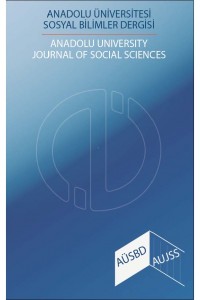Teknolojik Belirleyicilik, Minimal Etki ve Bilişsel Çelişki Kuramları Bağlamında Gerçek Ötesi Kavramı
Öz
Bu çalışmada, nesnel gerçeklerin belirli bir konu üzerinde kamuoyunu belirlemede duygulardan ve kişisel kanaatlerden, daha az etkili olması ve bireylerin nesnel gerçeklikleri görmezden gelerek belirli bir öznel gerçekliğe inatla bağlı kalması olarak tanımlanan gerçek ötesi kavramı teorik olarak incelenmektedir. Bu inceleme, siyasal iletişim bağlamında ve McLuhan tarafından geliştirilen teknolojik belirleyicilik kuramı, Klapper tarafından geliştirilen minimal etki kuramı ve Festinger tarafından geliştirilen bilişsel çelişki kuramı temel alınarak yapılmaktadır. Teknolojik belirleyicilik kuramı, günümüz iletişim teknolojileri ile değişen insan hayatının, insani değer ve pratiklerin, internet ve sosyal medya ile evrim geçiren bilgiye ulaşma, haber alma, kendini ifade etme ve iletişim kurma biçimlerinin nesnel gerçekliğin önemini azaltarak öznel gerçekliği vurgulaması ve gerçek ötesine ivme kazandırmasını açıklamak için çerçeve olarak kullanılmaktadır. Klapper’ın minimal etki kuramı, insanların sadece kendi fikir, inanç ve tutumları ile uyuşan mesajları arama, kabul etme ve hatırlama eğilimini, bugünün medya çeşitliliği ortamında ve bireylerin gelişmiş haber kaynaklarını kişiselleştirebilme becerilerinin etkilerini dikkate alarak incelemek ve gerçek ötesi kavramı ile ilişkilendirmek için çalışmaya dâhil edilmiştir. Festinger’ın bilişsel çelişki kuramı ise insanların neden gerçek ötesine meylettikleri konusunda bir anlayış geliştirmek için kullanılmıştır
Anahtar Kelimeler
Gerçek Ötesi Teknolojik Belirleyicilik Minimal Etki Bilişsel Çelişki Siyasal İletişim
Kaynakça
- Altay, Ç. (2005). McLuhan. Nurdoğan Rigel, Gül Batuş, Güleda Yücedoğan, Barış Çoban (Ed.), Kadife Karanlık, 21. Yüzyıl İletişim Çağını Aydınlatan Kuramcılar içinde (s. 9-74). İstanbul: Su.
- Anık, C. (2016). Siyasal İkna. İstanbul: Derin. Biggs, T. (2016, 9 Mart). Donald Trump Twitter-bot is hilarious and terrifyingly real. The Sydney Morning Herald. Erişim Tarihi 20 Ocak 2018, http://www.smh.com.au/technology/innovation/donaldtrump-twitterbot-is-hilarious-and-terrifyinglyreal-20160308-gne1ya.html
- Carr, N. (2010). The shallows: What the internet is doing to our brains. New York: W. W. Norton &Company.
- Chernenko, J. (2017). Political Storytelling in Digital Culture: A Tool for Post-Truth Politics. Communications, Media, Design, 2(1), 77-88.
- Festinger, L. (1957). A Theory of Cognitive Dissonance. California: Stanford University Press.
- Garfield, L. (2016, 27 Eylül). 3 Things an MIT scientist Learned About How Donald Trump Speaks by Studying His Debates. Business Insider. Erişim Tarihi 10 Ocak 2018, http://www.businessinsider.com/how-donald-trump-talks-2016-9
- Hermida, A., Fletcher, F., Korell, D., Logan, D. (2012). Share, Like, Recommend. Decoding the Social Media News Consumer. Journalism Studies 13(5-6), 815-824
- Horton, H. (2016, 24 Mart). Microsoft Deletes ‘Teen Girl’ AI After It Became a Hitler-Loving Sex Robot After 24 Hours. The Telegraph. Erişim Tarihi 10 Ocak 2018, http://www.telegraph.co.uk/ technology/ 2016/03/ 24/ microsofts-teen-girl-ai-turns-into-a-hitler-loving-sex-robot-wit/
- Kapko, M. (2016, 3 Kasım). Twitter’s impact on 2016 presidential election is unmistakable. CIO. Erişim Tarihi: 12 Ocak 2018, http://www.cio.com/article/3137513/social-networking/twitters-impact-on-2016-presidential-election-is-unmistakable.htm
- Keyes, R. (2017). Hakikat Sonrası Çağ, Günümüz Dünyasında Yalancılık ve Aldatma. Deniz Özçetin, (Çev). İzmir: Tudem. (Özgün eser 2004 tarihlidir).
- Klapper, J. T. (1957). What We Know About the Effects of Mass Communication: The Brink of Hope. Public Opinion Quarterly, 2, 453-474.
- Kristof, N. (2009, 18 Mart). The Daily Me. The New York Times. Erişim Tarihi 11 Ocak 2018, http://www.nytimes. com /2009/03/19/opinion/19kristof.html
- Kulak, Ö. Platon’dan Strauss’a: Düzenin Kurulmasında ve Korunmasında Soylu Yalanın Rolü. Viraverita E-Dergi, 5, 35-48. Erişim Tarihi 15 Ocak 2018, https://viraverita.org/sites/default/files/edergi-yazilari/platondan-straussa-duzenin-kurulmasinda-ve-korunmasinda-soylu-yalanin-rolu.pdf
- Kwak, H., Lee, C., Park, H., Moon, S. (2010). What is Twitter, A Social Network or a News Media? World Wide Web Conference April 26-30 (591-600). Raleigh, North Caroline, USA: WWW 2010.
- Laybats, C. ve Tredinnick, L.(2016). Post Truth, Information, and Emotion. Business Information Review, 33(4), 204-206.
- Loh, K. K., & Kanai, R. (2015). How has the internet reshaped human cognition? The Neuroscientist. Erişim Tarihi 18 Ocak 2018, http://www.ncbi.nlm.nih.gov/pubmed/2617000
- McPherson, M., Smith-Lovin, L., ve Cook, J. M. (2001). Birds of a Feather: Homophily in Social Networks. Annual Review of Sociology 27, 415-444.
- Merrill, J. (2015, 5 Aralık). How Donald Trump Talks. The New York Times. Erişim Tarihi 18 Ocak 2018, https://www. nytimes.com /interactive/2015/12/05/us/politics/donald-trump-talk.html
- Naaman, M., Boase, J., ve Lai, C-K. (2010). Is it really about me? Message content in social awareness streams. K. Inkpen ve C. Gutwin (Eds.), Proceedings of the 2010 ACM Conference on Computer Supported Cooperative Work içinde (ss.. 189–192). New York: ACM Press.
- News Use Across Social Media Platforms 2017. Erişim Tarihi 9 Ocak 2018 http://www. journalism. org/2017/09/07/news-use-across-social-media-platforms-2017/
- Ott, B. L. (2017). The Age of Twitter: Donald J. Trump and the Politics of Debasement. Critical Studies in Media Communication, 34(1), 59-68.
- Schwarz, N. ve Newman, E. J. (Mayıs 2017). How Does the Gut Know Truth? The Psychology of “Truthiness”. Psychological Science Agenda. Erişim Tarihi 10 Ocak 2018, http://www.apa.org/science/about/psa/2017/08/gut-truth.aspx
- Sternlight, J. R. ve Robbennolt, J. K. (2015). Psychology and Effective Lawyering: Insights for Legal Education. Journal of Legal Education, 64(3), 365-384.
- Stieglitz, S., ve Dang-Xuan, L. (2013). Emotions and information diffusion in social media—senti-ment of microblogs and sharing behavior. Journal of Management Information Systems, 29(4), 217–47.
- Tait, A. (2015, 4 Ağustos). The strange case of Marina Joyce and internet hysteria. The Guardian. Erişim Tarihi 20 Ocak 2018, https://www.theguardian. com/technology/2016/aug/04/marina-joyceinternet-hysteria-witch-hunts cyberspace?CMP =oth_b-aplnews_d-1
- Thelwall, M., Buckley, K., & Paltoglou, G. (2011). Sentiment in Twitter events. Journal of the American Society for Information Science and Technology, 62(2), 406–418.
- Word of the year 2016. Erişim Tarihi 17 Ocak 2018, https://en.oxforddictionaries. com/ word-of-theyear/word-of-the-year-2016
- Yaylagül, L. (2016). Kitle İletişim Kuramları, Egemen ve Eleştirel Yaklaşımlar. Ankara: Dipnot.
- Zhao, D. ve Rosson, M. B. (2009). How and Why People Twitter: The Role That Micro-Blogging Plays in Informal Communication at Work. GROUP’04 May 10-13 (243-252), Sanibal Island, Florida,USA.
- Zimmerman, A. S. (2010). Funding Irrationality. Duke Law Journal, 59(1105), 1133-1152.
- Zuckerman, E. (2013). Cute Cats to the Rescue? Participatory Media and Political Expression. Erişim Tarihi: 17 Ocak 2018, http://ethanzuckerman.com/ papers/cutecats2013.pdf
Ayrıntılar
| Birincil Dil | Türkçe |
|---|---|
| Bölüm | Makaleler |
| Yazarlar | |
| Yayımlanma Tarihi | 21 Mart 2019 |
| Gönderilme Tarihi | 16 Mart 2018 |
| Yayımlandığı Sayı | Yıl 2019 Cilt: 19 Sayı: 1 |
Cited By
İnternet Kullanıcısının Post Truth Çağdaki Rolü
Selçuk Üniversitesi Sosyal Bilimler Enstitüsü Dergisi
https://doi.org/10.52642/susbed.1405957
Bu eser Creative Commons Atıf-GayriTicari 4.0 Uluslararası Lisansı ile lisanslanmıştır.


